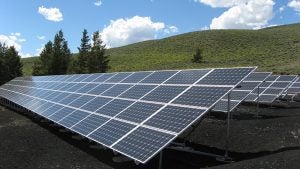Here’s how New Jersey can capitalize on its best clean energy investment opportunities
 Governor-elect Phil Murphy’s clean energy agenda has the potential to be a game-changer for New Jersey. His influence can position the state to regain its leadership in the fight against climate change, and create a clean energy economy that will lead to more jobs, and improve the health and well-being of all New Jerseyans.
Governor-elect Phil Murphy’s clean energy agenda has the potential to be a game-changer for New Jersey. His influence can position the state to regain its leadership in the fight against climate change, and create a clean energy economy that will lead to more jobs, and improve the health and well-being of all New Jerseyans.
To capitalize on this opportunity and achieve the state’s goals of clean, resilient, and affordable energy and transportation systems, we need to build on the progress we’ve made with new policies and programs that will allow the adoption of renewable energy technologies, energy efficiency, and clean transportation infrastructure at scale.
With New Jersey’s many competing investment needs, how will we pay for a much needed clean energy transformation? Public funds, whether from tax payers or utility customers, are not enough. EDF’s latest report, Financing New Jersey’s Clean Energy Economy: Pathways for Leadership, analyzes three innovative financial approaches that leverage public resources to catalyze private investment in these technologies.
[Tweet “Here’s how New Jersey can capitalize on its best clean energy investment opportunities.”]
The Big 3 investment opportunities
There are three areas where clean energy investment opportunities remain largely untapped:
- Renewable Energy –According to estimates from the National Renewable Energy Laboratory (NREL) New Jersey’s solar market potential is estimated at $40 billion, despite being the state with the fifth-most installed solar generating capacity in the country. Untapped offshore wind offers New Jerseyans the potential to generate over 300 terawatt hours of electricity per year, more electricity than the entire state’s current consumption.
- Energy efficiency – New Jersey ranks 23rd in the country when it comes to estimated potential for energy savings. Yet, current programs to reduce energy use and increase efficiency only achieve one-eighth of this potential.
- Electric vehicles – New Jersey’s transportation sector accounts for over 50 percent of the state’s energy-related carbon emissions. Still, New Jersey is only 2.2 percent on its way to achieving its goal of having 15 percent of car total sales be electric vehicles by 2025.
Policy strategies
What tools can we use to invigorate New Jersey’s clean energy investment?
New Jersey’s RPS and other existing rebates don’t position the state to meaningfully penetrate the full market. The state needs to adopt other finance mechanisms in order to build a robust clean energy economy.
Institutional strategies
The Garden State should also establish institutional solutions that use limited public resources, while increasing consumer protections:
- A Public State Bank – We could create a clean energy financing unit within a new public State Bank, dedicated to clean transportation projects and energy efficiency upgrades.
- NJ Environmental Infrastructure Trust (EIT) expansion – Soon to become the NJ Infrastructure Bank, the EIT’s portfolio could be expanded to cover clean energy projects across multiple markets and sectors. This would follow the approach taken by the Rhode Island Infrastructure Bank, where the existing state clean water financing agency had its mandate and funding expanded to serve clean energy projects in addition to water.
- A stand-alone Green Bank – Based on the models established by Connecticut and New York, New Jersey could establish a dedicated public, quasi-public, or non-profit institution that finances the deployment of renewable energy, energy efficiency, and other clean energy infrastructure projects in partnership with private lenders.
Financial Tools
New Jersey can also make available financial tools that encourage private investment. Tools must be market-oriented: flexible and adaptable to react to market changes. At the same time, we need to envision at the outset ways to help low-to-moderate income households access efficiency and other clean energy upgrades.
- Bonds – Green Bonds, Environmental Impact Bonds, and Qualified Energy Conservation Bonds are good tools for New Jersey to consider.
- PACE – Property Assessed Clean Energy (PACE) legislation would allow the state to authorize commercial buildings to finance energy upgrades on their tax bill. PACE is a financing model that helps local governments and the private sector back energy efficiency and renewable energy upgrades for homes and businesses. Some states are even using PACE to give new life to historic buildings.
- Community Solar – Community Solar projects benefit multiple home and business customers who don’t have the ability to install rooftop solar. The best community solar programs will include partnerships with local non-profits and community leaders, like we’re seeing in Los Angeles, Colorado, and North Carolina, for example.
New Jersey can and must move forward quickly to establish the institutions and adopt the mechanisms needed to encourage private investment that will create vibrant clean energy and clean transportation economies that will benefit all New Jerseyans.











One Comment
Really ? PACE ? the PACE program is nothing more than the government taxing it’s residents for making improvements. We already pay the highest taxes in the nation. We do not need PACE.
While I agree that we need funding sources and banking involved, I disagree that these should be “public”. The EDA is a prime example of a bad bank. They loan/grant millions of dollars to companies that do not need the funds. There needs to be a private bank “examiner” to vet out the funding and payback on clean energy projects.